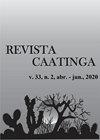施用高剂量醋液后甘蔗多溶胶的化学特性
IF 0.9
4区 农林科学
Q3 AGRONOMY
引用次数: 0
摘要
摘要在甘蔗作物中使用高剂量的酒糟会改变土壤的化学特性。本研究的目的是评估施用高剂量的醋液对用甘蔗培养210天的Ultisol的化学特性的影响。所用的处理剂量相当于0(D0)、150(D150)、300(D300)、600(D600)和1200(D1200)m3 ha-1的酒糟,再加上矿物肥料的对照处理。实验设计完全随机,共有六次治疗和六次重复。在种植(DAP)后90、120、150和210天分析了可交换钾(K)、钙(Ca)、镁(Mg)和钠(Na)含量、有机质、阳离子交换容量、钠吸附率、可交换钠百分比、电导率和pH,以及在0-0.20和0.20-0.40米深处210天的微生物基础呼吸。在甘蔗适宜的范围内,土壤pH值随酒糟的使用而增加,从6.2到6.4不等。K和Na含量最高的是D600和D1200;最高的K和Na有效性分别出现在120DAP和150DAP,表明这些营养物质之间对交换位点的竞争。有机物含量根据所施用的酒糟剂量成比例地高。D600和D1200剂量增加了土壤中的Na含量,在0-0.20 m深度处增加幅度更大。本文章由计算机程序翻译,如有差异,请以英文原文为准。
Chemical attributes of an ultisol cultivated with sugarcane after application of high doses of vinasse
ABSTRACT The use of high doses of vinasse in sugarcane crop can cause modifications in the chemical characteristics of the soil. The aim of this study was to evaluate the effect of the application of high doses of vinasse on the chemical characteristics of an Ultisol cultivated with sugarcane for 210 days. The treatments used were doses equivalent to 0 (D0), 150 (D150), 300 (D300), 600 (D600) and 1200 (D1200) m3 ha-1 of vinasse plus a control treatment with mineral fertilization. The experimental design was completely randomized with six treatments and six repetitions. Exchangeable potassium (K), calcium (Ca), magnesium (Mg) and sodium (Na) contents, organic matter, cation exchange capacity, sodium adsorption ratio, exchangeable sodium percentage, electrical conductivity and pH were analyzed at 90, 120, 150 and 210 days after planting (DAP), in addition to microbial basal respiration at 210 days at depths of 0-0.20 and 0.20-0.40 m. Soil pH increased with the use of vinasse within the proper range for sugarcane, varying from 6.2 to 6.4. The highest K and Na contents were found at D600 and D1200; the highest K and Na availability occurred at 120 DAP and 150 DAP, respectively, indicating competition between these nutrients for exchange sites. Organic matter content was proportionally high according to the vinasse dose applied. D600 and D1200 doses increased Na content in the soil, with greater magnitude at the 0-0.20 m depth.
求助全文
通过发布文献求助,成功后即可免费获取论文全文。
去求助
来源期刊

Revista Caatinga
AGRONOMY-
CiteScore
2.10
自引率
11.10%
发文量
67
审稿时长
6-12 weeks
期刊介绍:
A Revista Caatinga é uma publicação científica que apresenta periodicidade trimestral, publicada pela Pró-Reitoria de Pesquisa e Pós-Graduação da Universidade Federal Rural do Semi-Árido – UFERSA, desde 1976.
Objetiva proporcionar à comunidade científica, publicações de alto nível nas áreas de Ciências Agrárias e Recursos Naturais, disponibilizando, integral e gratuitamente, resultados relevantes das pesquisas publicadas.
 求助内容:
求助内容: 应助结果提醒方式:
应助结果提醒方式:


